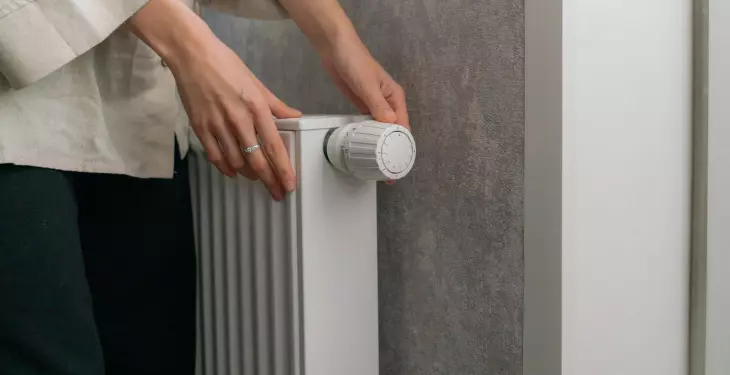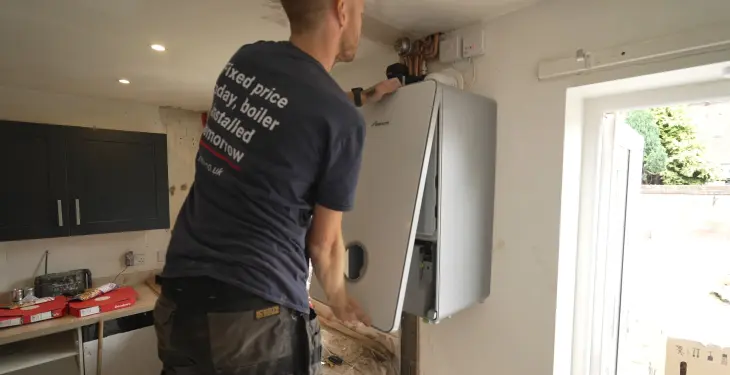



Written by Stephen Day
Gas Safe Engineer
Updated: 15th August, 2025
Boilers are the heartbeat of a home's central heating system, efficiently managing the balance between cosy warmth and energy conservation.
Get a new boiler quote, save up to £550 per year (0% APR available).
Setting the correct temperature for your boiler is essential for maintaining a balance between effective heating and energy efficiency. Central heating systems are a crucial aspect of ensuring your home remains warm and comfortable, especially during the colder months.
The ideal boiler temperature for your central heating system generally falls between 60°C and 70°C. This range is sufficiently high to heat your home efficiently without expending unnecessary energy.
Adapting your boiler settings to the seasonal changes can also optimise performance and contribute to reducing your heating bills. In the winter, a higher temperature setting may be required to maintain a warm environment, while during milder weather, lowering the temperature can suffice.
It is important to note that the boiler temperature should not drop below 60°C, as this can raise the risk of Legionnaires' disease due to bacterial growth in cooler water.
Get a quote in 60 seconds, fitted as fast as next day!
0% APR finance available.
Boilers are the heartbeat of a home's central heating system, efficiently managing the balance between cosy warmth and energy conservation. A typical household boiler comes in various types, such as the combi boiler, which provides on-demand heating and hot water without the need for a separate cylinder.
Condensing boilers are a common choice due to their higher efficiency levels. These boilers capture heat from exhaust gases that would otherwise be expelled, reusing it to preheat cold water entering the boiler. This process is not only environmentally savvy but can also be cost-effective for homeowners.
Efficiency in boilers is often indicated by an A-rated efficiency label. Such boilers are over 90% efficient, conforming to stringent regulations aimed at reducing carbon footprints and fuel bills.
Here's a brief breakdown:
Combi Boiler-
Advantages: Space-saving, instant hot water, no need for a tank.
Efficiency: Better for smaller homes with fewer demands for simultaneous hot water use.
Condensing Boiler-
Advantages: High efficiency, lower carbon emissions, potentially lower heating bills.
Efficiency: A-rated models offer more than 90% efficiency.
Understanding the type of boiler that one has installed can be crucial in deciding how to set it for optimal operations. Adjusting the temperature atop these boilers ensures they perform reliably, without wasting energy.
When adjusting the settings, a balance is sought. Temperatures hovering around 65°C for central heating prove effective for most households. It maintains a comfortable environment and dovetails with energy-saving strategies. It's not only about warmth; it's about smartly managing household energy.
Selecting the correct boiler type for a home is essential for efficient heating and hot water supply. Combi, heat-only, and system boilers offer diverse options to suit different household needs.
When considering the best brands for each boiler type, buyers have various reputable companies to choose from:
Combi Boilers: Ideal for smaller households, combi boilers provide hot water and heating without the need for a separate tank. Worcester Bosch and Vaillant are leaders in this category, praised for their reliability and efficiency.
Heat-Only Boilers: Also known as conventional or regular boilers, these are typically used in homes with traditional radiator systems. Baxi and Potterton are noted for their durable models that work well with existing heating setups.
System Boilers: These work with unvented hot water cylinders and are suitable for modern homes. Viessmann and Glow-worm stand out due to their innovative features such as weather compensation technology.
Setting the ideal boiler flow temperature is essential for ensuring both energy efficiency and household comfort during the colder months. Homeowners may be uncertain about the optimal settings for their central heating systems.
For Central Heating:
The recommended flow temperature for boilers during winter is typically between 60ºC (140ºF) and 70ºC (158ºF).
At 60ºC, a boiler’s flow temperature is warm enough to heat most homes efficiently.
Room Temperature:
Thermostats should generally be set to maintain a comfortable room temperature between 18ºC to 21ºC.
Fine-tuning your thermostat can result in better energy savings while maintaining comfort.
For Condensing Boilers:
A common temperature setting for central heating output in condensing boilers is near 70°C.
Hot water should ideally be set around 60°C to balance efficiency and safety.
Adjusting boiler temperatures correctly can have a significant impact on reducing energy usage without sacrificing comfort. Here's a swift guideline:
Boiler Type | Flow Temperature Setting |
Standard Boilers | 60°C - 70°C |
Condensing Boilers | ~70°C for heating |
60°C for hot water |
Remember that any adjustments made to your boiler should be done with consideration of your specific heating requirements and the manufacturer’s recommendations. In addition, always consult with a heating professional if you are unsure about settings or if your boiler is not operating efficiently.
The central heating temperature in one's home directly impacts both comfort and energy efficiency. Radiators should ideally operate at optimal temperatures, balancing the need for warmth with the conservation of energy.
For general comfort, a room thermostat can be set to maintain a steady ambient room temperature, typically around 20°C for living areas. Bedrooms, by contrast, may require slightly cooler conditions for a better sleeping environment, approximately 18°C.
Radiator Heating Temperature: A recommended setting is 75°C for the boiler output temperature to heat living spaces effectively. However, for hot water, the recommended range lies between 50°C to 60°C to prevent scalding and ensure bacteria such as Legionella do not propagate.
Thermostat Settings:
Living Areas: Around 20°C
Bedrooms: Around 18°C
Using a room thermostat allows homeowners to maintain these temperatures efficiently. They respond to changes in room temperature and adjust the boiler operation accordingly, contributing to a consistent level of warmth.
Furthermore, setting the maximum radiator temperature to 80°C is considered efficient for most homes. Yet, it is worth noting that every degree above the optimal range can reduce boiler efficiency by about 10 to 20%.
In conclusion, one should adjust their boiler and radiator settings carefully, considering the different zones within their dwelling. This will ensure both a warm home environment and prudent energy use.
Setting the optimal temperature for central heating systems is key for both energy efficiency and ensuring a comfortable indoor environment. Efficient performance of a heating system is not just about the right temperature, but also how heat is distributed and controlled throughout the property.
One must ensure that radiators evenly distribute heat, enhancing both comfort and efficiency. This is achieved through a process known as balancing. Balancing involves adjusting the valves on each radiator to ensure that they all heat up at the same rate. Begin with the radiator closest to the boiler, usually having the most heat, and adjust the others accordingly, which often means gradually reducing the flow as one moves further from the heat source. An optimal balance can prevent certain areas from being too hot or too cold, contributing to a more efficient heating system by reducing the unnecessary workload on the boiler.
Thermostatic Radiator Valves (TRVs) provide individual control over the temperature in each room. These valves can be set to the desired level, from 1 (coolest) to 5 (warmest), depending on the room usage and personal preference. They monitor the air temperature around them and adjust the flow of hot water entering the radiators accordingly. By installing TRVs, it's possible to lower the heat in rooms that are seldom used or to maintain a lower temperature in bedrooms for a comfortable night’s sleep. They offer a practical method to enhance the performance of the central heating system while scaling back on unnecessary energy use.
Central heating systems are governed by a variety of controls that manage the temperature and efficiency of the system. Boiler thermostats are a primary component, allowing users to set the preferred temperature for their boiler's output.
Modern systems often include digital displays, providing real-time information and greater precision over settings. Users can adjust heating controls via:
Dials: Allowing manual adjustments to the thermostat setting, usually marked with indicative temperature ranges.
Digital display and controls: Enabling precise temperature settings and may include programmable features.
Control systems can vary from basic manual controls to advanced smart thermostats that learn from one's habits. The latter can be adjusted remotely and may offer detailed analytics on usage patterns.
The selection of the ideal temperature setting on a boiler thermostat should consider both comfort and energy efficiency. As per expert advice, a setting between 60°C (140°F) and 70°C (158°F) is usually recommended for colder weather. However, it's important to note that every home is different, and adjustments may be required to find the perfect balance.
Proper use of this equipment not only maintains the desired warmth in one's home but can also lead to appreciable energy savings. Load compensation controls and weather compensation controls are further enhancements that optimise boiler operation by adjusting the flow temperature according to either the load or outdoor conditions, maximising efficiency without compromising on comfort.
Controlling your boiler's flow temperature is an effective strategy for curbing energy consumption. For combi boilers, temperatures are often set higher than necessary. By tuning the flow temperature to suit your needs — between 60ºC and 70ºC — you can minimise energy usage without compromising on comfort.
In addition to managing flow temperatures, consider updating heating controls. Implementing a programmable thermostat allows precise scheduling of heating times.
Radiator maintenance is also pivotal. Ensuring radiators are balanced and the system is free from obstructions can markedly improve efficiency.
The following list details practical steps to lower heating bills:
Adjust the boiler flow temperature: Ideal range is 60ºC–70ºC.
Update heating controls: Install programmable or smart thermostats.
Balance radiators: Ensures even distribution of heat.
Regular maintenance: Includes cleaning and possibly power-flushing the system.
Zone heating is another tactic, directing warmth to occupied areas of the home whilst reducing output in vacant rooms. This selective approach sharpens efficiency.
Remember that these adjustments don't just lower emissions; they also help households withstand the rigours of energy price volatility. By adopting these measures, one can strike a balance between maintaining a warm home and navigating the landscape of energy costs judiciously.
Maintaining the right water temperature in hot water cylinders is vital for both energy efficiency and health. Hot water should be stored at a minimum of 60°C to prevent the growth of Legionella bacteria, which can cause Legionnaires' disease, a serious lung infection.
The water temperature in central heating systems requires careful monitoring. It is recommended that hot water used for consumption, such as bathing or washing, should be distributed at 50°C to prevent scalding. The use of thermostatic mixing valves is crucial as they blend hot and cold water to achieve a safe outlet temperature.
Factor | Temperature | Purpose |
Hot Water Storage | At least 60°C | Prevents Legionella bacteria growth |
Hot Water Distribution | Around 50°C | Balances safety to prevent scalding and maintains health standards |
Controlling water temperature is also paramount in preventing the buildup of limescale and other deposits which can impair boiler and system efficiency. Regular checks and adjusting the temperature settings according to seasonal changes assists in sustaining the central heating’s effectiveness.
Conclusively, one should never underestimate the importance of maintaining water quality. By adhering to appropriate temperature settings and utilising safety devices, they ensure that hot water systems are both safe from bacteria like Legionella and operate efficiently, extending their lifespan and preventing unnecessary repairs.
As the seasons transition, the need for central heating fluctuates. In the colder months, boilers should maintain higher temperatures to compensate for the chill. A setting between 60-70°C for radiators can suffice, allowing a comfortable ambient warmth.
Modern boilers often come equipped with weather compensation technology. This feature allows the heating system to adjust in accordance with external temperatures. On a milder day, the technology reduces the boiler temperature, conserving energy without sacrificing comfort.
When a boiler operates in condensing mode, it works at peak efficiency by recycling heat from exhaust gases. This mode is more effective at lower temperatures, making it ideal for the gentle warmth required in spring or autumn. To maintain condensing mode, keeping the temperature around 55°C is advisable.
Below is a quick reference for adjusting your boiler temperature with seasonal changes:
Season | Suggested Radiator Temperature (°C) |
Spring/Autumn | 55 - 60 |
Winter | 60 - 70 |
Mild Winter Days | Weather compensation active |
It's important to fine-tune your settings, keeping in mind the boiler's efficiency and the household's comfort. A periodic system check is recommended to ensure your boiler's optimal performance throughout the year.
When managing the temperature of boilers for central heating, safety is paramount. A Gas Safe registered engineer should always conduct installations and repairs, ensuring that standards are met and risks are minimised. In the UK, strict regulations govern these practices to protect homeowners and tenants.
Boiler pressure is one critical aspect to monitor. It must be within the manufacturer's recommended range to prevent malfunctions. Homeowners should frequently check the boiler's pressure gauge, and if anomalies arise, professional intervention is advised.
Regarding carbon emissions, it's a legal requirement for boilers to comply with specific efficiencies set by UK Building Regulations. This influences not only safe operation but also environmental impact. Reducing temperatures can lower emissions but should balance with household warmth needs.
Regular maintenance checks by certified professionals can detect risks such as carbon monoxide leaks, which are silent yet deadly. Boilers must be assessed periodically to guarantee their integrity and efficient function.
Here is an essential checklist for safe boiler operation:
Ensure Gas Safe registered engineers conduct all servicing.
Monitor and maintain optimal boiler pressure.
Regular inspections for wear and potential carbon monoxide leaks.
Compliance with UK standards to reduce carbon emissions.
A mindful approach to boiler maintenance and adherence to regulations doesn't only safeguard one's home but also contributes to broader environmental efforts.
Homeowners often face challenges when setting the temperature of their boilers for central heating. Understanding common issues can help maintain an efficient and reliable heating system.
Incorrect Temperature Dial Settings: The dials on a boiler regulate the hot water temperature and the flow to radiators and water cylinders. Setting these dials incorrectly can result in water that is either too hot or not warm enough, affecting both comfort and energy consumption.
Optimal Temperature Range: For central heating, the water should generally be around 60°C to 70°C. Below this range, radiators may not heat up sufficiently, while above it, energy wastage increases.
Hot Water Cylinder Settings: If a home uses a water cylinder, its temperature setting must also be considered. A common issue arises when the cylinder thermostat is set too high, which not only wastes energy but can also scale the system over time.
Balancing Efficiency and Comfort: Some individuals attempt to lower their bills by reducing the boiler temperature significantly, but this can compromise home warmth. Conversely, a temperature setting that is too high may lead to excessive energy bills without noticeably improving the warmth.
Intermittent Temperature Fluctuations: Inconsistent heating can often stem from faulty dials or thermostats that cause sporadic temperature changes. Frequent thermostat adjustments to counter this can wear the system and lead to inefficiencies.
In troubleshooting boiler temperature settings, users should ensure their dials are accurately calibrated and periodically checked, considering both radiators and water cylinders.
Regular maintenance and a clear understanding of optimal temperature ranges can prevent these common issues, striking a balance between efficiency and a comfortably heated home.
Get a quote in 60 seconds, fitted as fast as next day!
0% APR finance available.
Last updated: 15th August, 2025

Written by Stephen Day
Gas Safe Engineer at iHeat
Stephen Day is a Gas Safe registered and FGAS certified engineer with over 20 years of hands-on experience in the heating, cooling, and renewable energy industry, specialising in boiler installations, air conditioning, and heat pump systems.
LinkedInArticles by Stephen Day are reviewed by iHeat’s technical team to ensure accuracy and reliability.

22nd December, 2025
Based on data from over 7000 boiler installations completed by iHeat in the past 12 months...
 Read Article
Read Article

22nd December, 2025
Here’s a quick roundup of the best combi boilers for 2026.
 Read Article
Read Article

22nd December, 2025
When your old boiler breaks down and it comes time to replace it with a new one, it might...
 Read Article
Read Article
No obligation. Takes less than 60 seconds.